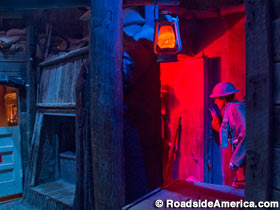
WWI trench scene.
Military Museums of Fort Leonard Wood
Fort Leonard Wood, Missouri
The 1990s was a decade of military realignment and base closings, which forced many of America's smaller, less mission-critical Army museums to shut their doors, their exhibits shipped off and stored for future redeployment. Three museums moved to Fort Leonard Wood and reopened -- with bigger galleries, and better exhibits -- under one roof.
The U.S. Army Chemical Corps Museum, Engineer Museum, and Military Police Museum are fascinating, especially viewed together. Those special regiments are not as well known as other infantry, armor and front line forces. Their role in key conflicts didn't usually grab the headlines. They may not have landed in force in the first wave on Omaha, but they probably laid down the smoke screens, cleared the mines, and directed traffic off the beach.
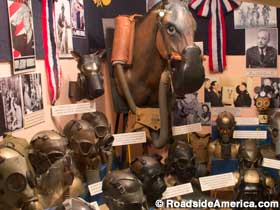
Gas mask display.
Each of the three museums has merits -- all populated by scores of dummies in dioramas, unfolding their stories in chronological sections and galleries. And each has its own gift shop!
We start with the Chemical Corps Museum, a favorite in Alabama years ago, much changed and expanded now. We enter through the best replica World War I trench in America (there are others), a short-but-effective wandering path past dugouts and barbed wire and a trench infirmary with a coughing (gassed) dummy soldier. Truly, the Golden Age of Gassing. Then it's out to the museum exhibits -- and since aerosol attacks are often invisible, it's the accompanying gear and gizmos that are displayed, much of it appealing in a very dark way.
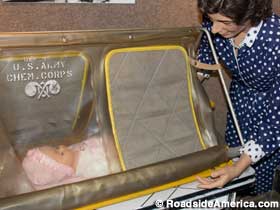
Baby chem cocoon.
The Mickey Mouse gas mask, for example, was a failed attempt to make chemical warfare fun for kids. It's a visitor favorite, hidden among a display of dozens of other gas masks. There's a photo of Walt Disney convening with military brass to discuss the cartoon mask development, and a picture of Charlie McCarthy donning a ventriloquist dummy-sized gas mask. Of even more interest are masks and suits designed for dogs, horses, and even pigeons. Museum curator Cynthia Riley told us that the animal wear was intended as a temporary exhibit, but visitors have loved it so much that she hasn't had the heart to take it down.
After World War I, much of the Chemical Corps Regiment's focus was on a gas warfare mission never executed -- a genie bottle never uncorked. But they played a key role in the conduct of conventional battle: artillery mortar units to deliver smoke screen shells, and flamethrowers, designed by the then Chemical Warfare Service in 1940-41. These items share exhibit space with nastier artifacts such as nerve gas land mines, and displays on Napalm and Agent Orange. Rubber suits, goggle-eyed masks, and portable filtration systems for troops are everywhere.
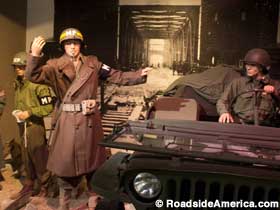
MP directs traffic at Remagen Bridge.
"Eventually the protective gear itself will kill you," said Cynthia, citing heat stroke as a prime culprit. Modern detection equipment, she said, eliminates unnecessary time spent in survival gear, as well as the dubious practice of ordering low-ranking soldiers to remove their masks to find out what happens. "I'm sure," she said, "that every private that graduates from basic training is really glad."
In one diorama, a 1950s housewife dummy in a home fallout shelter gazes lovingly at a baby doll sealed in a chemical warfare tent-cocoon. The Chemical Corps view of the modern world can be seen in a model of an Army Doomsday truck, sealed against radiation, chemical, and biological death, and a diorama of a dummy in a hazmat suit removing anthrax from someone's office desk.
For a breather (no mask required), we walked down the hall to the Military Police and Army Engineer museums, each surprisingly substantial.
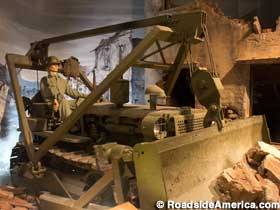
Bulldozing rubble in the Army Engineer Museum.
We admit, our collective knowledge of MPs comes from old movies -- they're the guys in armbands and pot helmets blowing whistles and breaking up GI bar fights, or directing military traffic in intersections. The MP Museum shows a wax dummy doing just that -- at the most important intersection of WWII, the entry to the last standing bridge across the Rhine into Germany (a piece of the Remagen bridge is outside the building entrance, along with a slab of Berlin Wall).
The exhibits show MPs performing other functions: they guard America's military prisons, they guard POWs, they guarded Allied Checkpoint Charlie at the Berlin Wall. There are displays on attack dog training, weapons confiscated from Cuban refugees, and a selection of board games and sleep aids issued to the prisoners at Guantanamo Bay. A gallery of MP-created art includes Ann-Margaret in Vietnam and terrified Iraqis, all under the watchful eyes of the military police.
Army Engineers are not exactly the same as the Army Corp of Engineers, the levee-building public works arm of the military. The regiment chronicled at this museum is chiefly comprised of combat engineers -- topographical engineers, port and tactical bridge builders, landmine experts and other special warfare support skills. They are also responsible for the thousands of temporary buildings created for training and housing troops, storing supplies and equipment, etc.
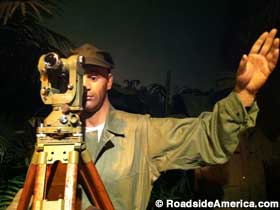
Army engineer surveyor.
The Engineer Museum has dioramas showing assembly of pontoon bridges in World War II and blast-proof walls in Afghanistan. One odd exhibit depicts unsuspecting Civil War Union troops and French WWI tanks about to be blown up by buried mines (implying that Army engineers might have cleared the way). It's the only one of the three museums displaying an atomic bomb replica, overhead in the 1941-1945 gallery. In the Vietnam war section, you can peek into the tunnel warrens of the enemy (in the Chemical Corps Museum, the Vietnam War section presents an ant farm-like, cutaway model of the enemy tunnel system).
Despite the appeal of the MP and Engineer museums, we found ourselves returning to the Chemical Corps collection for a last look at its eerie artifacts. We asked Cynthia if visitors ever tried to handle the exhibits -- maybe kids who never developed proper respect for the military -- and she reminded us that we were in a museum about chemical warfare. "I tell people, 'You might want to think twice before you touch anything,'" she said. "Your best approach is to keep your hands in your pockets."





